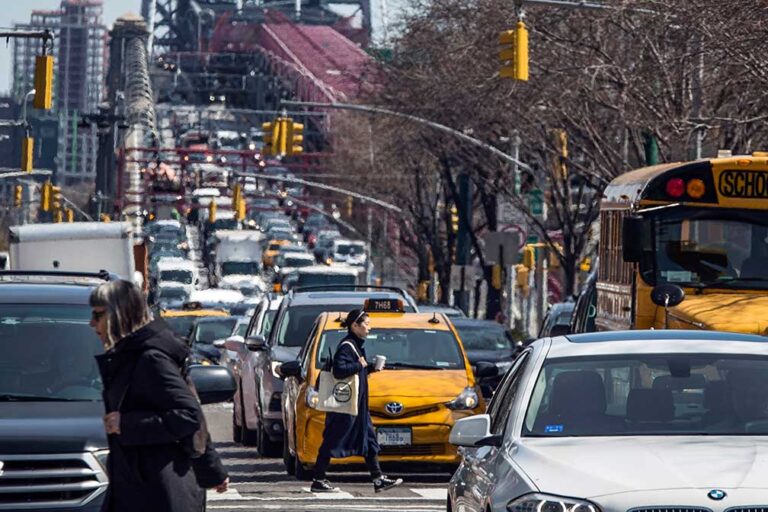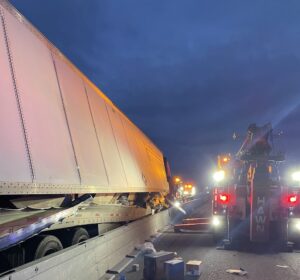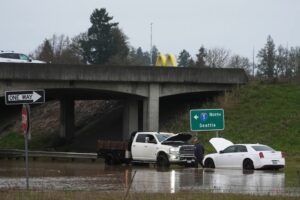NEW YORK — Rather than alienate suburban commuters in an election year, New York’s governor slammed the brakes last spring on a plan to launch America’s first “congestion pricing” tolling system to discourage people from driving into the most traffic-choked parts of Manhattan.
Back then, Gov. Kathy Hochul said it was the wrong time to hit commuters and businesses with a $15 toll. However, the Trucking Association of New York (TANY) announced in June that, while it welcomed the temporary reprieve, that it would continue to proceed with a lawsuit fighting the toll hike.
Now, with President-elect Donald Trump headed for the White House, the Democrat is hurriedly restarting the tolling plan — hoping to get it in place before the Republican follows through on a promise to kill it for good during his first week in office.
Hochul’s new plan, unveiled Nov. 14, calls for a $9 fee on most vehicles, which would help fund the city’s cash-strapped public transit system but at a lower price tag for drivers.
However, the tolls are steeper for large commercial trucks and buses, ranging from $14.40 to $21.60 each trip during daytime tolling hours.
The new tolling rate system is scheduled to begin Jan. 5.
“I’m proud to announce we have found a path to fund the MTA, reduce congestion and keep millions of dollars in the pockets of our commuters,” Hochul said from her office in midtown.
The fee would be imposed on most vehicles driving into Manhattan neighborhoods south of 60th Street and collected via license plate readers. It would come on top of the often-hefty tolls drivers pay to enter the island borough via some bridges and tunnels.
Trucking interests vow to strike back.
The Trucking Association of New York (TANY) was quick to respond to Hochul’s renewed efforts.
“While political leadership is now saying the right things about bringing down the cost of living in the state, New Yorkers should not be fooled by the rhetoric: this new congestion pricing plan is still bad for the economy, will still cause supply chain disruptions, and will still raise the price of goods upon which households across the five boroughs and its surrounding suburbs rely,” said Kendra Helms, TANY president, adding that the association will continue to fight the plan.
According to Helms, the fundamental issue with the tolling plan remains the same — the pricing for large trucks and delivery vehicles is disproportionate to the cost for smaller passenger vehicles.
The plan “unfairly targets trucking operators, is a burdensome regulatory framework and cost imposition on the industry responsible for transporting 90% of goods in New York State,” Helms said.
“The governor rightly paused the plan in June, acknowledging the state’s affordability crisis…. However, she failed to mention that industry experts on both sides of the Hudson have long warned that the discriminatory way trucks and logistics companies are targeted by the plan will increase costs for residents everywhere,” she said. “Trucking operators may be forced to raise prices to afford these tolls, which will drive up costs for New Yorkers. “
Last spring, Hochul said she was worried that imposing the tolls could hinder New York City’s continuing recovery from the COVID-19 pandemic. But she also promised her sudden about-face on the toll wasn’t permanent and that she would put forward a new plan.
Public transit and environmental advocates, who had howled when Hochul “paused” the plan weeks before its June launch, lauded Thursday’s return.
However, the decision to maintain a per-trip charge — rather than creating a per-day tolling structure — is unfair to commercial drivers, according to Helms. As an added insult, she says, members of the trucking industry were “entirely excluded from all discussions pertaining to the reinstatement of this plan.”
Congestion pricing is aimed at reducing traffic and pollution while encouraging use of public transit. It has long existed in other cities around the globe, including London, Stockholm, Milan and Singapore, but not in the U.S.
“Congestion pricing cannot happen soon enough,” said Danny Pearlstein, a spokesperson for the Riders Alliance, which had been among the local groups that sued Hochul over her decision to halt the program. “Once the first tolls are collected, we will finally breathe easier.”
But the plan may face obstacles in Washington, with Republicans poised to take control of the White House and Congress in January.
Trump, whose Trump Tower penthouse would be within the congestion pricing zone, said Thursday that he “strongly” disagrees with Hochul’s decision to revive congestion pricing, calling it “the most regressive tax known to womankind.”
“It will put New York City at a disadvantage over competing cities and states, and businesses will flee,” he said in a statement. “Not only is this a massive tax to people coming in, it is extremely inconvenient from both driving and personal booking keeping standards. It will be virtually impossible for New York City to come back as long as the congestion tax is in effect.”
Republican Rep. Sam Graves of Missouri, chair of the House Transportation and Infrastructure Committee, called the plan’s revival after the election a “blatantly political move” and said in a statement his panel “will consider all options to conduct the necessary oversight of this issue as we move forward.”
The program, which state lawmakers approved in 2019, stalled for years awaiting a required federal environmental review during Trump’s first term before being approved by the administration of President Joe Biden.
In a statement, the Federal Highway Administration said it is “working expeditiously to finalize the needed steps to complete the agreement.”
It is also unclear exactly how Hochul’s revised plan would address lost revenue for mass transit from lowering the toll amount. The original fee scheme was expected to generate up to $1 billion a year for subways, buses and commuter rail systems.
On Thursday, officials insisted the money raised from the lower fee will still be enough to allow the Metropolitan Transportation Authority to go ahead with its plans for fixes and upgrades — but it may take longer to generate the revenue to pay back the costs, they said.
The toll can still be raised, though Hochul said she does not want to do that for at least three years.
Also yet to be seen: How politically costly the revival of the plan might be for Hochul among people who get around by car.
Democratic and Republican lawmakers representing some of the city’s suburbs panned the toll’s return.
“Governor Hochul’s congestion pricing scheme is nothing more than a massive new tax on working families, daily commuters, college students, and local residents who just want to travel within the city they call home,” said U.S. Rep. Michael Lawler, a Republican who represents suburban communities just north of the city.
Residents and workers in midtown Manhattan also had reasons to grumble.
Miles Toussant, a 63-year-old chef who lives in midtown, said he’s concerned about the increased cost of visiting his 88-year-old mother in Brooklyn.
He checks in with her around three times a week, and prefers to take Ubers or taxis, but he also knows riders in the toll zone will be assessed a per-trip surcharge under the plan.
“There are also people who are still going to have to come into Manhattan regardless, so how much is it really going to change the congestion?” Toussant said. “And then what is that money going to be used for?”
Ed Saleh, whose family runs a produce stand across the street from where the governor made her announcement, said the new fee would come on top of $45 a day in tolls their company already pays to drive their large truck into midtown from New Jersey.
“If it comes into play, we have no choice: we still have to be here,” he said, noting that trucks will pay higher fees under the plan. “But it’s just not fair. We contribute a lot to New York.”
Saleh said he is also worried about the impact on foot traffic to their corner business.
“The tolls on their own are already crazy. To add another $9 on top of that is definitely going to hurt a lot of people,” he said. “The economy is not doing too great. People aren’t spending. Putting another fee is just going to make people’s lives a little tighter.”
TANY will continue to fight the plan, Helms promised.
“… the Trucking Association of New York remains committed to seeing out the legal process and is hopeful that our ongoing litigation will preserve business-as-usual for New Yorkers,” she said.
By Philip Marcelo, The Associated Press. The Trucker News Staff also contributed to this report.
The Associated Press is an independent global news organization dedicated to factual reporting. Founded in 1846, AP today remains the most trusted source of fast, accurate, unbiased news in all formats and the essential provider of the technology and services vital to the news business. The Trucker Media Group is subscriber of The Associated Press has been granted the license to use this content on TheTrucker.com and The Trucker newspaper in accordance with its Content License Agreement with The Associated Press.















